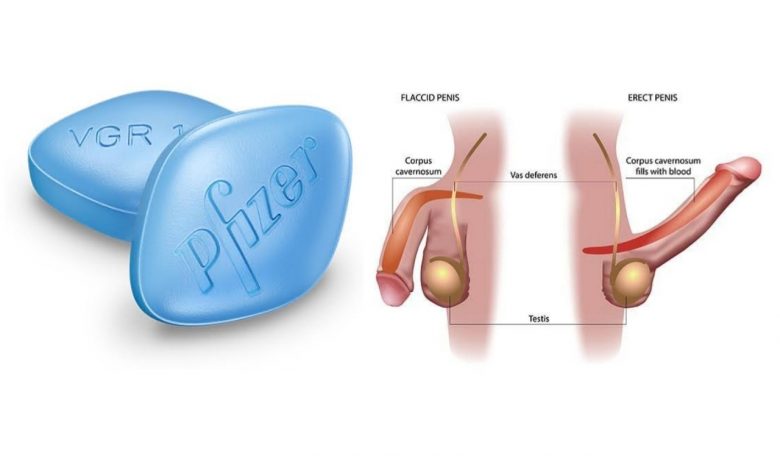Does Taking Viagra Increase The Size of Your Penis?

What is Viagra?
Viagra is a brand of sildenafil, a medication that is approved to treat erectile dysfunction (ED). With ED, you’re unable to have or maintain an erection. Viagra is approved for this use in males ages 18 years and older.
Viagra belongs to a class of drugs called phosphodiesterase type 5 (PDE5) inhibitors. (A class of drugs is a group of medications that act in a similar way.) Viagra works by increasing blood flow to your penis, which helps you have and keep an erection. But this drug only works if you’re sexually aroused.
As a medication, Viagra comes as tablets that are taken by mouth. In most cases, it should be taken about an hour before sexual activity, but it can be taken 30 minutes to 4 hours beforehand. Viagra is available in three strengths: 25 mg, 50 mg, and 100 mg. For Viagra to work properly, it should be taken an hour before sex on an empty stomach.
How Long Does Viagra Stay in Your System?
The medicinal effects of Viagra typically last for three to four hours, after which the medication stops being effective at preventing erectile dysfunction. If you take Viagra on a fairly empty stomach and do not eat a large meal after using it, it will typically take five to six hours for it to exit your system.
Small amounts of Viagra could remain in your system for up to 20 hours. Certain side effects of Viagra, such as nasal congestion, facial flushing, and heartburn, can continue for several hours after the medication exits your system.
In this article we shall be looking at the size of the penis and whether Viagra can make your penis to appear bigger.
Penis size?
Human penises differ in size on a number of measures, including length and circumference when flaccid and erect. Besides the natural variability of human penises in general, there are factors that lead to minor variations in a particular male, such as the level of arousal, time of day, room temperature, anxiety level, sports activity, and frequency of sexual activity. Compared to other primates, including large examples such as the gorilla, the human penis is thickest, both in absolute terms and relative to the rest of the body.
Generally, the size of a penis can greatly influence a person’s confidence when it comes to having sex. With that said, there is often a mismatch between how someone with a penis views themselves and how a potential partner sees them. This is especially true if the person thinks that their penis is “too small.”
According to a study published in the Journal of Health Psychology, around 68% of men surveyed said they had concerns about their penis size. The concerns are largely driven by unrealistic expectations in the media—as well as society at large—about what is an “average-size” penis. This is a problem.
A review of research carried out in 2020 on penis size found that the average length of an erect penis is between 5.1 inches and 5.5 inches. Factoring in volunteer bias, the researchers believe that the average falls closer to the lower end of that range. Older research pegged the average length of a flaccid penis at 3.61 inches based on available data.
Does Viagra make you bigger or thicker?
No, taking Viagra or any other brand of sildenafil cannot increase the size of your penis or make it thicker. Viagra work by helping to relax muscles and arteries inside the penis, which helps more blood reach the penis. When aroused and only when aroused the combination of relaxation and increased blood flow helps fill the penis with blood and give you a bigger erection.
Viagra is not a penis enlargement medication, even pills that usually contain vitamins, minerals, herbs, or hormones that manufacturers claim enlarge the penis have not been proved to work. And some may be harmful.
Side effects of Viagra
Viagra may cause some unwanted side effects.
Side effects may include:
- sensitivity to light
- muscle aches
- heartburn
- nose bleeding
- flushed skin
- problems falling asleep
- tingling in the arms, feet, legs, or hands
- numbness in the arms, feet, legs, or hands
- headache
- diarrhea
- heartburn
- trouble differentiating between colors like blue and green
- seeing a blue tinge on things
Viagra may also cause serious side effects that require immediate medical attention. Symptoms may include:
- chest pain
- fainting
- blurred vision
- severe, sudden loss of vision
- ringing in ears
- sudden loss of or decrease in hearing
- dizziness
- rash
- burning during urination
- itching during urination
- shortness of breath that worsens
- an erection that lasts longer than 4 hours and may be painful
Some medicines can cause unwanted or dangerous effects when used with Viagra. Tell your doctor about all your current medicines, especially riociguat (Adempas) and nitrates.
Do not take Viagra if you are also using a nitrate drug for chest pain or heart problems, including nitroglycerin, isosorbide dinitrate, isosorbide mononitrate, and some recreational drugs such as “poppers”. Taking sildenafil with nitrate medicine can cause a sudden and serious decrease in blood pressure.
Contact your doctor or seek emergency medical attention if your erection is painful or lasts longer than 4 hours. A prolonged erection (priapism) can damage the penis.
Stop using Viagra and get emergency medical help if you have sudden vision loss. You may Find Useful information on Can You Take Viagra with Metoprolol Tartrate?





